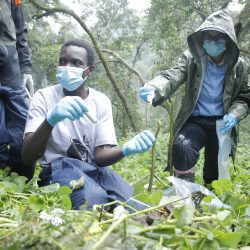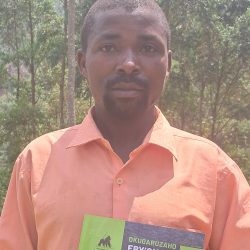Sector I: A day with a mountain gorilla census team
Blog | 26/09/11
We went out knowing that we were in the known territory of unhabituated groups of mountain gorillas as well as the recently habituated tourism group Oruzogo. We were conducting reconnaissance trails in Bwindi Impenetrable National Park’s Sector I and while we couldn’t expect to find anything noteworthy on that particular day, anything was possible.
Last week, I told you about the Kyaguliro family group and how it has already been counted in the ongoing census of mountain gorillas of Bwindi. What lays behind the census are hundreds of dedicated and intrepid conservationists from Uganda, Rwanda, and Democratic Republic of Congo (and a handful of ‘muzungus’ from the US, UK, Germany, and Australia). We started the day at ‘command central’ in the ITFC meeting room going over the map of Bwindi including the Sector that we were responsible for on that day. I say ‘we’ because I was and still am very proud to be considered as part of their ranks, even for one short day.
What teams are currently doing in Bwindi Impenetrable National Park in Uganda is referred to the sweep method and its the forth time it’s been used to census mountain gorillas in Bwindi. The sweep refers to the systemmatic movement of coordinated teams from east to west through Bwindi, making sure that no solitary gorilla or gorilla group is left uncovered. Again, with the idea that the goal is not to encounter gorillas themselves, but to uncover evidence of their existence, most specifically their night nests and feces.

Results from the previous censuses using the sweep method plus the additional genetic analyses initiated in 2006. This will be the second census in which the sweep method and genetic analyses are used.
In 2006, the last time a census of Bwindi’s mountain gorillas was conducted, census teams systematically walked 600 km within the forest looking for gorillas and signs of other fauna as well as illegal human activities.
For my honorary day searching for gorillas with the census team, I accompanied the team led by Ismael Bakebwa from Mgahinga Gorilla National Park, participating in his 4th census. On the trail out to where we would start our ‘recce’ trail, he described to me how everyone on the team had a job to do. “Everyone has a job to do in the team,” he said. “There is a trail cutter with a machete, David, in front, followed by Lawrence, who is guiding him as to which direction to go.” Ismael himself was in charge of the mapping and recording. Harriet was in charge of all the work with the GPS, taking waypoints, and logging the distance covered in relation to the map (not the actual hills!). Raymond was a spotter and Olison was armed with a riffle to protect the group should any chance encounters with elephants or other temperamental animals. My job was to stay on my feet and keep up. While I can’t say I performed with flying colors, I actually didn’t do too badly.
With a map, a compass, and a GPS, the team is fully equipped to navigate their way through Sector I, doing ‘recce’ trails of about 500 m distance between, sweeping back and forth in tandem with other teams working in neighboring sectors. They did this effortlessly, with little delay as the entire team was briefed on what was planned and the roles they had to play.
As we went off trail and started the ‘recce’ trail, the team fell silent as they looked for evidence of gorillas. We moved slowly, one of the benefits of cutting a new trail, until someone shouted “Chimpanzee” and pointed up. What we saw was not a chimp, but a week-old nest high in a tree. Several others were located and the GPS point and the number were quickly noted and we continued on.
Over the course of a few hours, we covered 1.5 km of ‘recce’ trail and encountered evidence of forest elephant, bush pigs, and mountain gorillas! We first crossed paths with an old gorilla trail and toward the end of our ‘recce’ trail, we came right through a gorilla nest site. This site was also older than the one week period considered for detailed recording as part of the census, with the idea that that group of gorillas will have moved quite a distance in that time and will be encountered by another group. It was discussed that it was likely the nesting site for the recently habituated Oruzogo family group as the team quickly counted at least 14 nests.
Ismael’s team has completed up to 8 km of reconnaissance trails in one day, which is just absolutely amazing and a true testament to the endurance and dedication of the team. And makes you realize how it is possible for teams to traverse the entirety of Bwindi (330 square kilometers) in the span of 6 weeks. Our day also brought some interesting discussions surrounding the issue of women participating in the census, as this team contained the only (yes, only) female participant in the census, Harriet Kyakyo, a volunteer with the Uganda Wildlife Authority stationed in Bwindi.
Harriet performed her duties the same as others in the team without trying to prove herself or make others accommodate her as a woman. My companion in this visit, Dr. Allan Carlson from WWF-Sweden, a member of the IGCP coalition, raised the issue over our packed lunch together. “Maybe next census we’ll see Harriet leading an all-women census team,” he prompted. Met with a lot of laughs and responses of, “not possible,” it made us think and discuss about why and why not? This has me thinking especially as I write this today, a day marked by the loss of Wangari Maathai, a champion for the role of women in conservation.
After leaving the team in Sector I to continue with the ‘recce’ trails, we encountered the team of porters on the trail that were responsible for moving our team from the base camp at Ruhija to a campsite deeper in the forest. Their contribution cannot be underestimated as well.

Community members from Ruhija serve as porters helping to shift campsites and keep the census teams well-stocked throughout the 6-week census.
I am extremely proud of my 1.5 km of ‘recce’ trail completed in Sector I. I am also extremely proud of the people who are the unspoken heros of mountain gorilla conservation, like Ismael on his 4th census and the rest of his team, and Harriet for putting herself out there, not knowing what she would encounter. The fact that she had a taste of the work and has again signed herself up for the last phase tells me that she just may emerge again and hopefully we can find more women like her to put themselves forward for a tough job and not one considered the norm for young women in Uganda. May the next census of Bwindi be not only trans-boundary (the subject of tomorrow’s blog) but also trans-gender! Absolutely no pun or joke about it.








